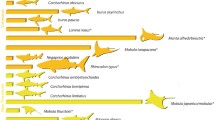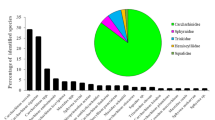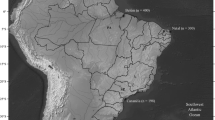Abstract
Southeast Asia is a major shark product trade hub, and many of the world’s largest shark product selling markets are located in the region. Malaysia is the second largest importer of shark fins in the world, approximately 2500 metric tonnes of fins were imported between 2000 and 2016. The country is also a major shark fisher—the eighth largest in the world in terms of yearly catch. Yet the composition of the species of shark involved in the Malaysian trade remains largely unknown. Not knowing the composition of the sharks involved in the fin trade in a major trade hub presents challenges when it comes to determining conservation goals, setting appropriate catch quotas and establishing new, or revisiting previous conservation listings. Using a fragment of the mtDNA COI gene we attempted to DNA barcode 147 dried shark fins. We identified a number of fins that belonged to species listed on either CITES appendix I, or II, and the composition of the sharks identified in samples collected from Peninsular Malaysia appears to be different from that of other trade hubs within the region. Given these differences, we suggest that further DNA barcoding studies be performed throughout the region at regularly repeated intervals to build a more comprehensive picture of the sharks involved in the trade within the region and globally, this information will be useful to policy makers and conservation planners.

Similar content being viewed by others
References
Abdullah A, Nurilmala M, Muttaqin E, Yulianto I (2020) DNA-based analysis of shark products sold on the Indonesian market towards seafood labelling accuracy program. Biodivers J Biol Divers. https://doi.org/10.13057/biodiv/d210416
Appleyard SA, White WT, Vieira S, Sabub B (2018) Artisanal shark fishing in Milne Bay Province, Papua New Guinea: biomass estimation from genetically identified shark and ray fins. Sci Rep. https://doi.org/10.1038/s41598-018-25101-8
Boon (2017) http://www.trafficj.org/publication/17_The_Shark_and_Ray_Trade_in_Singapore.pdf
Cardeñosa D (2019) Genetic identification of threatened shark species in pet food and beauty care products. Conserv Genet. https://doi.org/10.1007/s10592-019-01221-0
Cardeñosa D, Fields A, Abercrombie D et al (2017) A multiplex PCR mini-barcode assay to identify processed shark products in the global trade. PLoS ONE 12:e0185368. https://doi.org/10.1371/journal.pone.0185368
Cardeñosa D, Fields AT, Babcock EA et al (2020) Species composition of the largest shark fin retail-market in mainland China. Sci Rep 10:12914. https://doi.org/10.1038/s41598-020-69555-1
Dulvy NK, Fowler SL, Musick JA et al (2014) Extinction risk and conservation of the world’s sharks and rays. eLife 3:e00590. https://doi.org/10.7554/eLife.00590
Dulvy NK, Simpfendorfer CA, Davidson LNK et al (2017) Challenges and priorities in shark and ray conservation. Curr Biol 27:R565–R572. https://doi.org/10.1016/j.cub.2017.04.038
Fields AT, Fischer GA, Shea SKH et al (2018) Species composition of the international shark fin trade assessed through a retail-market survey in Hong Kong: Shark Fin Trade. Conserv Biol 32:376–389. https://doi.org/10.1111/cobi.13043
Fields AT, Fischer GA, Shea SKH et al (2020) DNA zip-coding: identifying the source populations supplying the international trade of a critically endangered coastal shark. Anim Conserv. https://doi.org/10.1111/acv.12585
French I, Wainwright BJ (2022) DNA barcoding identifies endangered sharks in pet food sold in Singapore. Front Mar Sci 9:9
Hobbs CAD, Potts RWA, Walsh MB et al (2019) Using DNA barcoding to investigate patterns of species utilisation in UK shark products reveals threatened species on sale. Sci Rep 9:1–10. https://doi.org/10.1038/s41598-018-38270-3
Karl SA, Castro ALF, Lopez JA et al (2011) Phylogeography and conservation of the bull shark (Carcharhinus leucas) inferred from mitochondrial and microsatellite DNA. Conserv Genet 12:371–382. https://doi.org/10.1007/s10592-010-0145-1
Kearse M, Moir R, Wilson A et al (2012) Geneious basic: an integrated and extendable desktop software platform for the organization and analysis of sequence data. Bioinformatics 28:1647–1649. https://doi.org/10.1093/bioinformatics/bts199
Kraft DW, Conklin EE, Barba EW et al (2020) Genomics versus mtDNA for resolving stock structure in the silky shark (Carcharhinus falciformis). PeerJ 8:e10186. https://doi.org/10.7717/peerj.10186
Kuguru G, Maduna S, da Silva C et al (2018) DNA barcoding of chondrichthyans in South African fisheries. Fish Res 206:292–295. https://doi.org/10.1016/j.fishres.2018.05.023
Leray M, Yang JY, Meyer CP et al (2013) A new versatile primer set targeting a short fragment of the mitochondrial COI region for metabarcoding metazoan diversity: application for characterizing coral reef fish gut contents. Front Zool 10:34. https://doi.org/10.1186/1742-9994-10-34
Liu CJN, Neo S, Rengifo NM et al (2021) Sharks in hot soup: DNA barcoding of shark species traded in Singapore. Fish Res 241:105994. https://doi.org/10.1016/j.fishres.2021.105994
Lobo J, Costa PM, Teixeira MA et al (2013) Enhanced primers for amplification of DNA barcodes from a broad range of marine metazoans. BMC Ecol 13:34. https://doi.org/10.1186/1472-6785-13-34
Marchetti P, Mottola A, Piredda R et al (2020) Determining the authenticity of shark meat products by DNA sequencing 9:1194
Martin R (2005) Conservation of freshwater and euryhaline elasmobranchs: a review. J Mar Biol Ass 85:1049–1073. https://doi.org/10.1017/S0025315405012105
Neo S, Kibat C, Wainwright BJ (2022) Seafood mislabelling in Singapore. Food Control 135:108821. https://doi.org/10.1016/j.foodcont.2022.108821
Oakes and Sant (2019) https://www.traffic.org/publications/reports/an-overview-of-major-shark-and-ray-catchers-traders-and-species/
O’Bryhim JR, Parsons ECM, Lance SL (2017) Forensic species identification of elasmobranch products sold in Costa Rican markets. Fish Res 186:144–150. https://doi.org/10.1016/j.fishres.2016.08.020
Oliver S, Braccini M, Newman SJ, Harvey ES (2015) Global patterns in the bycatch of sharks and rays. Mar Policy 54:86–97. https://doi.org/10.1016/j.marpol.2014.12.017
Pacoureau N, Rigby CL, Kyne PM et al (2021) Half a century of global decline in oceanic sharks and rays. Nature 589:567–571. https://doi.org/10.1038/s41586-020-03173-9
Prasetyo AP, McDevitt AD, Murray JM, et al (2020) Disentangling the shark and ray trade in Indonesia to reconcile conservation with food security. bioRxiv 2020.12.08.416214. https://doi.org/10.1101/2020.12.08.416214
Sembiring A, Pertiwi NPD, Mahardini A et al (2015) DNA barcoding reveals targeted fisheries for endangered sharks in Indonesia. Fish Res 164:130–134. https://doi.org/10.1016/j.fishres.2014.11.003
Shivji M, Clarke S, Pank M et al (2002) Genetic identification of pelagic shark body parts for conservation and trade monitoring. Conserv Biol 16:1036–1047
Wainwright BJ, Ip YCA, Neo ML et al (2018) DNA barcoding of traded shark fins, meat and mobulid gill plates in Singapore uncovers numerous threatened species. Conserv Genet 19:1393–1399. https://doi.org/10.1007/s10592-018-1108-1
Ward RD, Holmes BH, White WT, Last PR (2008) DNA barcoding Australasian chondrichthyans: results and potential uses in conservation. Mar Freshwater Res 59:57. https://doi.org/10.1071/MF07148
Author information
Authors and Affiliations
Corresponding author
Ethics declarations
Conflict of interest
The authors have no conflicts of interest to declare.
Additional information
Publisher's Note
Springer Nature remains neutral with regard to jurisdictional claims in published maps and institutional affiliations.
Simon Hew is an independent researcher.
Rights and permissions
About this article
Cite this article
Seah, Y.G., Kibat, C., Hew, S. et al. DNA barcoding of traded shark fins in Peninsular Malaysia. Rev Fish Biol Fisheries 32, 993–999 (2022). https://doi.org/10.1007/s11160-022-09713-y
Received:
Accepted:
Published:
Issue Date:
DOI: https://doi.org/10.1007/s11160-022-09713-y




